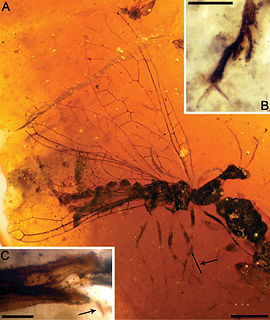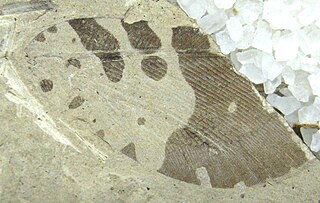
Hemerobiidae is a family of Neuropteran insects commonly known as brown lacewings, comprising about 500 species in 28 genera. Most are yellow to dark brown, but some species are green. They are small; most have forewings 4–10 mm long. These insects differ from the somewhat similar Chrysopidae not only by the usual coloring but also by the wing venation: hemerobiids differ from chrysopids in having numerous long veins and forked costal cross veins. Some genera are widespread, but most are restricted to a single biogeographical realm. Some species have reduced wings to the degree that they are flightless. Imagines (adults) of subfamily Drepanepteryginae mimic dead leaves. Hemerobiid larvae are usually less hairy than chrysopid larvae.

Psychopsidae is a family of winged insects of the order Neuroptera. They are commonly called silky lacewings.

Styporaphidia is a genus of snakefly, belonging to the extinct family Mesoraphidiidae, containing up to two species, the type species Styporaphidia magia and tentatively Styporaphidia? hispanica. The genus was named from the Greek stypos meaning "stem" or "stump" and Raphidia, the type genus for, and most often used as, a stem for generic names in the order Raphidioptera. The species name of S. magia is from the Greek word mageia meaning "magic" while the species name for S.? hispanica is from the Latin Hispania meaning "Spain" in reference to the type locality of the species.

Archiinocellia is an extinct genus of snakefly in the family Raphidiidae known from Eocene fossils found in western North America. The genus contains two species, the older Archiinocellia oligoneura and the younger Archiinocellia protomaculata. The type species is of Ypresian age and from the Horsefly Beds of British Columbia, while the younger species from the Lutetian Green River Formation in Colorado. Archiinocellia protomaculata was first described as Agulla protomaculata, and later moved to Archiinocellia.
Microberotha is an extinct monotypic genus of "beaded lacewing" in the family Berothidae known from a fossil found in North America. When described the genus contained a single Ypresian-age species Microberotha macculloughi.

Allorapisma is an extinct genus of lacewing in the moth lacewings family Ithonidae. The genus is solely known from two Eocene fossils found in North America. At the time of description the genus was composed of a single species, Allorapisma chuorum.

Mesoraphidiidae is an extinct family of snakeflies in the suborder Raphidiomorpha. The family lived from the Late Jurassic through the Late Cretaceous and is known from twenty-five genera. Mesoraphidiids have been found as both compression fossils and as inclusions in amber. The family was first proposed in 1925 by the Russian paleoentomologist Andrey Vasilyevich Martynov based on Upper Jurassic fossils recovered in Kazakhstan. The family was expanded in 2002 by the synonymizing of several other proposed snakefly families. The family was divided into three subfamilies and one tribe in a 2011 paper, further clarifying the relationships of the included genera.

The Stenophlebiidae is an extinct family of medium-sized to large fossil odonates from the Upper Jurassic and Cretaceous period that belongs to the damsel-dragonfly grade ("anisozygopteres") within the stem group of Anisoptera. They are characterized by their long and slender wings, and the transverse shape of the discoidal triangles in their wing venation.

The Tarsophlebiidae is an extinct family of medium-sized fossil odonates from the Upper Jurassic and Lower Cretaceous period of Eurasia. They are either the most basal member of the damsel-dragonfly grade ("anisozygopteres") within the stem group of Anisoptera, or the sister group of all Recent odonates. They are characterized by the basally open discoidal cell in both pairs of wings, very long legs, paddle-shaped male cerci, and a hypertrophied ovipositor in females.

Ainigmapsychops is an extinct genus of lacewing in the silky lacewing family Psychopsidae. The genus is solely known from an Eocene fossil found in North America. At the time of its description the new genus was composed of a single species, Ainigmapsychops inexspectatus.

Elektrithone is an extinct genus of lacewing in the moth lacewings family Ithonidae. The genus is solely known from an Eocene fossil forewing found in Europe. At the times of description the genus was composed of a single species, Elektrithone expectata.
Principiala is an extinct genus of lacewing in the moth lacewings family Ithonidae. The genus is known from Cretaceous fossils found in South America, Europe, and possibly Asia. The genus is composed of two species, the type species Principiala incerta, and Principiala rudgwickensis.
Wesmaelius mathewesi is an extinct species of lacewing in the neuropteran family Hemerobiidae known from an Eocene fossil found in North America
Cretomerobius is an extinct genus of lacewings in the neuropteran family Hemerobiidae known from fossils found in Asia. The genus currently contains a single species, the Aptian C. disjunctus.
Makarkinia is an extinct genus of lacewings in the family Kalligrammatidae described by Martins-Neto in 1997 from fossils found in the Crato Formation of the Araripe Basin in northeastern Brazil. The genus contains two species dating to the Late Aptian, Makarkinia adamsi and Makarkinia kerneri.

Camelomecia is an extinct genus of stem-group ants not placed into any Formicidae subfamily. Fossils of the single known species, Camelomecia janovitzi, are known from the Middle Cretaceous of Asia. The genus is one of several ants described from Middle Cretaceous ambers of Myanmar.
Prosisyrina is an extinct genus of lacewing in the neuropteran family Sisyridae. The genus contains two described species, Prosisyrina sphinga and Prosisyrina sukachevae. Prosisyrina is known from a group of Late Cretaceous fossils which were found in Asia.
Paradoxosisyra is an extinct genus of lacewing in the spongefly family, Sisyridae. The genus contains a single species, Paradoxosisyra groehni and is placed into the extinct subfamily Paradoxosisyrinae. Paradoxosisyra is known from a solitary Middle Cretaceous fossil which was found in Asia.

Dipteromantispidae is an extinct family of neuropterans known from the Cretaceous period. Unlike other neuropterans, the family possesses only a single set of fully developed forewings, with the hindwings reduced to haltere like structures. They are generally small in size and possess raptorial forelegs. They are considered to belong to Mantispoidea, with an uncertain position within the clade.

Palaeopsychops is an extinct genus of lacewing in the moth lacewings family Ithonidae. The genus is known from Early Eocene fossils found in Europe, and North America and is composed of ten species. The ten species can be informally separated into two species groups based on veination of the forewings, the "European" and "North American" groups. When first described, the genus was placed in the family Psychopsidae, but later was moved to Polystoechotidae, which itself is now considered a subgroup of the moth lacewings.













